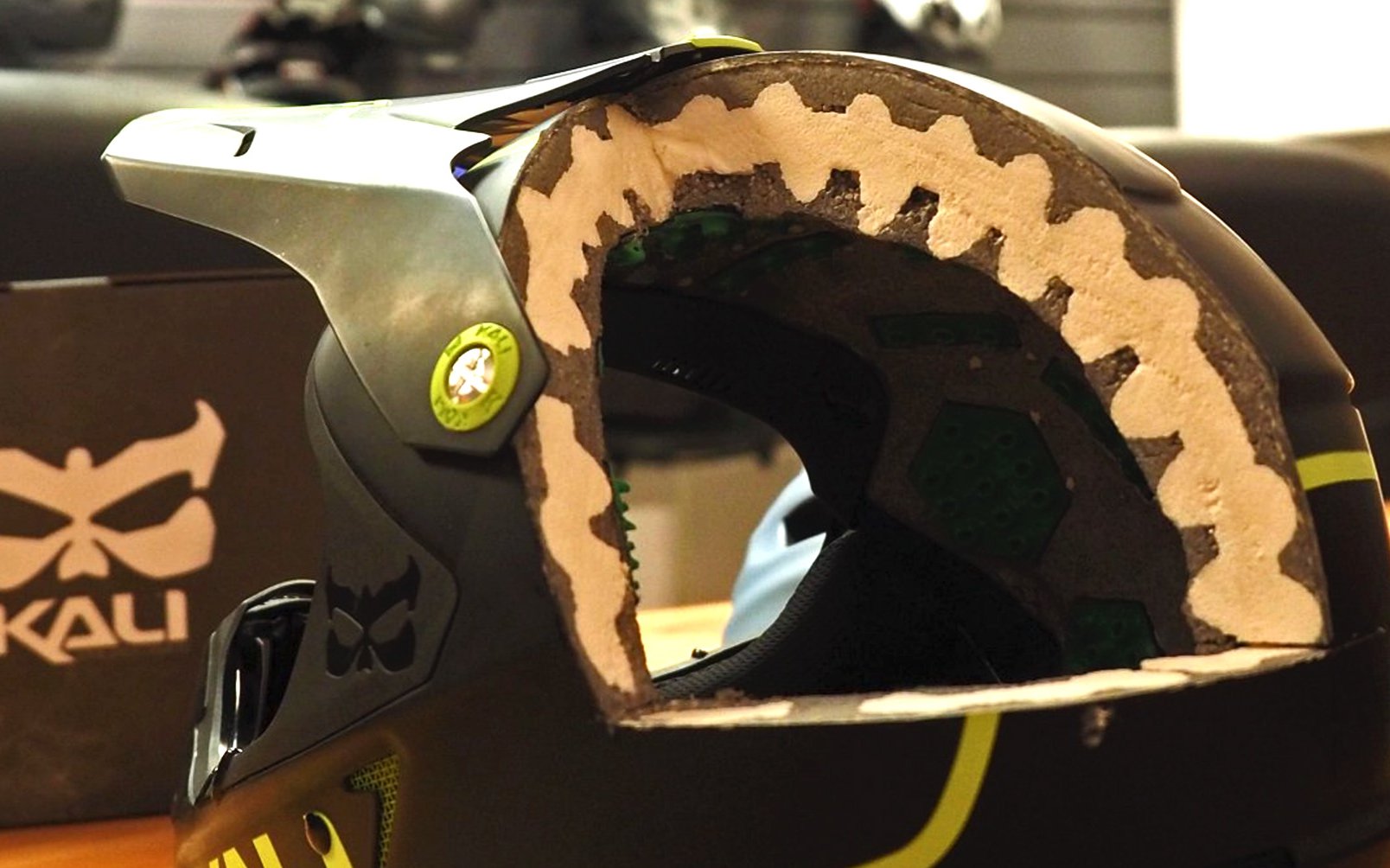
EDITORIAL
Bike Helmets Are Too Hard (with Kali's Brad Waldron)
"Philosophy vs Engineering"
With a self-deprecating laugh and knowing smile, Kali's Brad Waldron is quick to note, "sure, I drink my own Koolaid." We're an hour into a rambling discussion on everything bike helmet and Brad is explaining the tao of Kali Protectives.
An aerospace engineer ("actually, I mostly broke stuff in a lab") turned bike industry composites engineer ("actually, I mostly broke stuff in a lab") turned helmet designer ("actually, I mostly broke stuff in a lab"), turned chief-of-everything at Kali my interpretation of our conversation really boils down to this simple doctrine:
- Bicycle helmets are too hard to most-effectively dissipate energy.
- Rotational forces deliver the "knock out punch" that creates many cycling brain injuries.
- Experimenting with new ideas is the key to delivering the safest products.
- Always be smashing stuff in the lab.
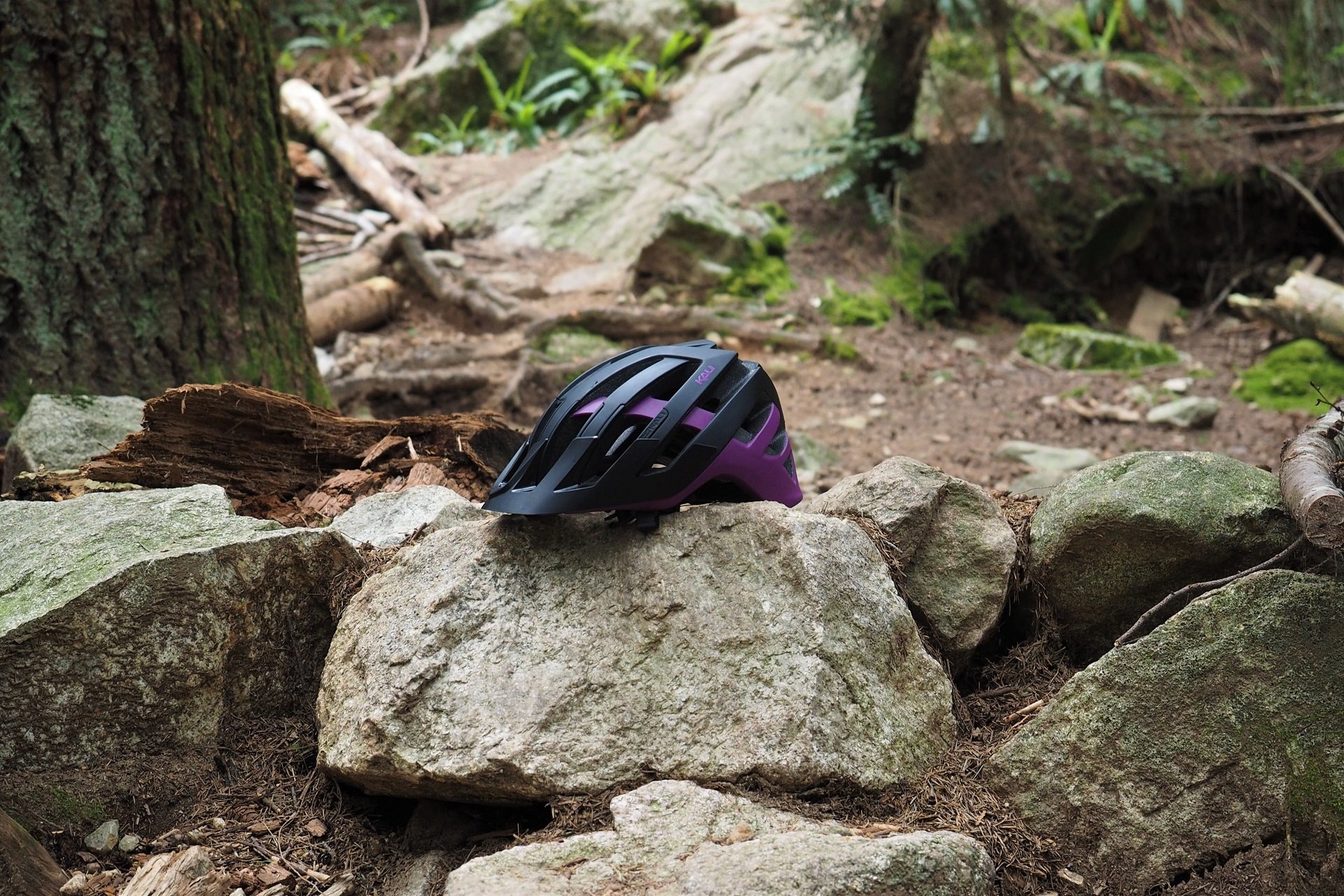
Kali's Interceptor looks like any high end all mountain lid. The key design challenge is balancing the venting riders expect with the softer foam Kali's design philosphy demands.
On paper that seems pretty simple. Helmets are too hard? Use softer foam! Rotational forces are the primary issue? Throw some money at MIPS! There's a plethora of new research in traumatic brain injuries coming from both sports and military data and there are established bicycle helmet standards to test against. Easy peasy.
The big reveal; implementing these new philosophies is not that simple. Also totally unsurprising; rider expectations for cool (looking & venting) lids are the biggest engineering barrier to overcome.
"Make It & Break It"
Brad and the crew at Kali have a reputation for trying new things. This covers ideas conceived in-house, adapting technologies from other applications, and new research or ideas pitched to the company by researchers. Whether it's the "green stuff"* developed at Imperial College dissipating energy inside Kali's top end lids, different in-molding techniques allowing for thinner shells, or tuning foam density; that means testing. A lot of testing. On the motorsports side, for example, Kali has full-face helmets with a jigsaw-puzzle of seven different foam densities. How do you decide how to lay up those layers? Apparently dropping an anvil on a container load of helmets isn't just therapeutic and fun - it's essential.
*The same as the "blue stuff" making up Leatt's 360° Turbines
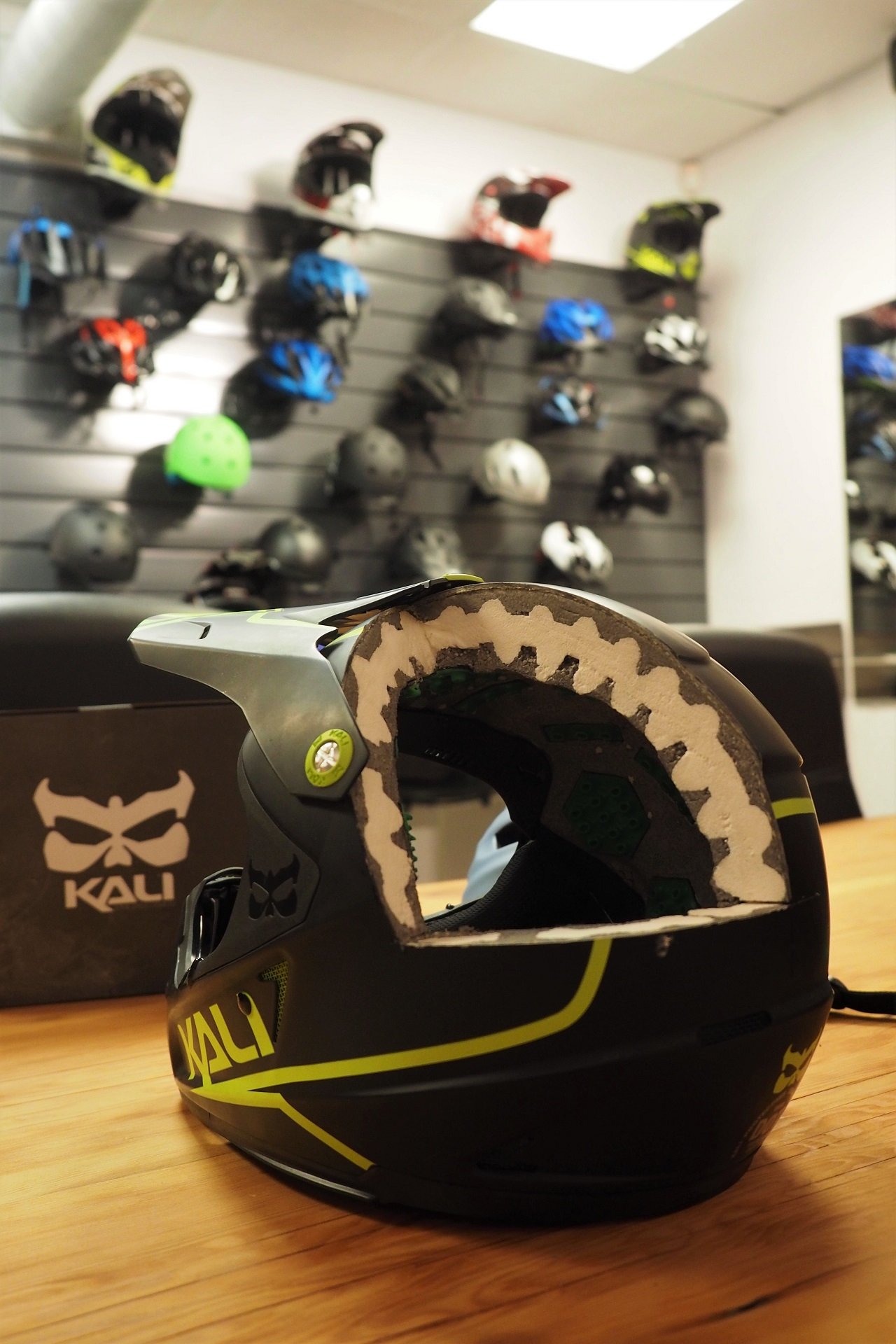
Multiple densities of foam to absorb impacts and handle sheer loads.
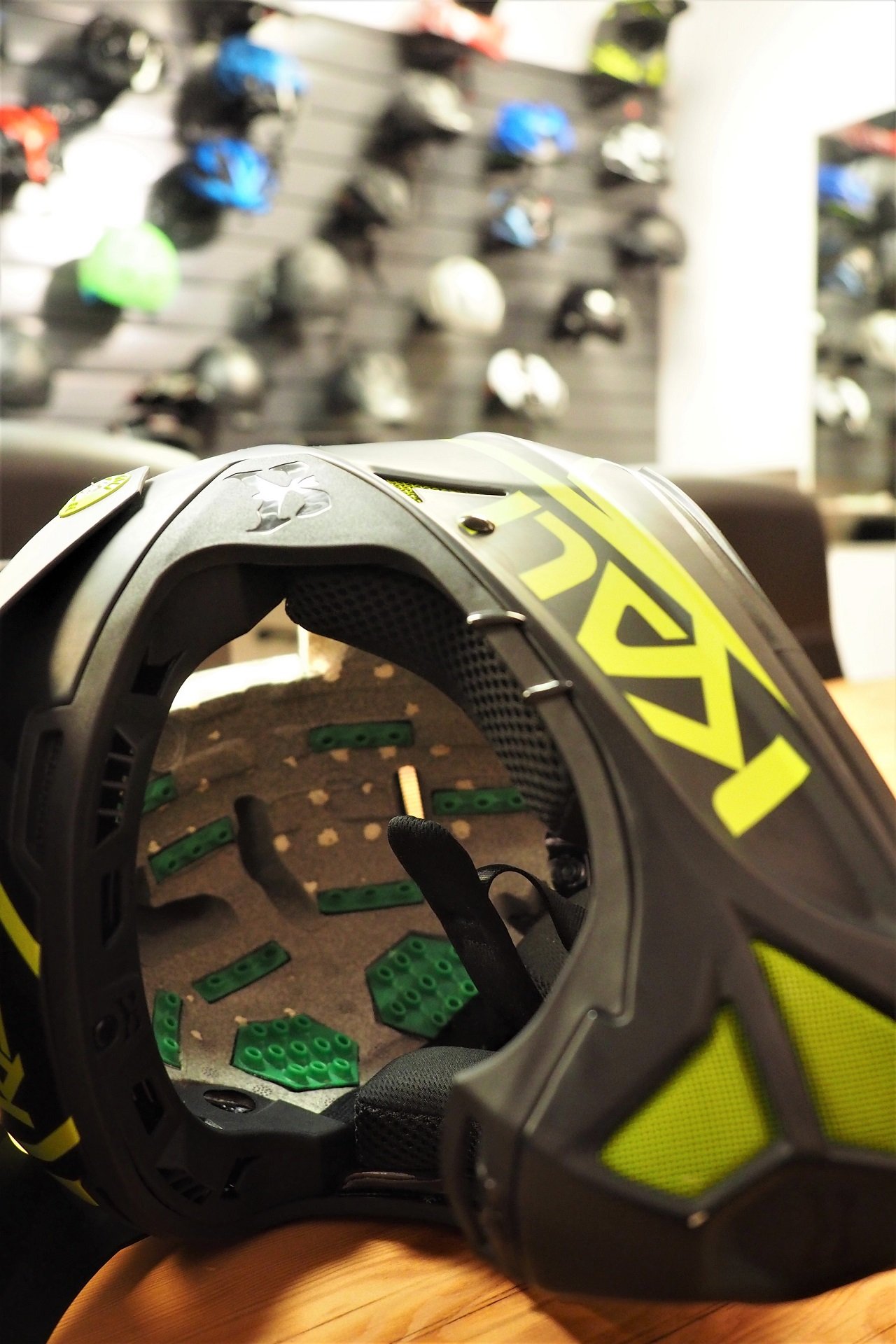
"Viscoelastic padding reduces rotational impact forces by up to 25%."
In addition to being his background, it's pretty obvious that Brad loves smashing stuff in a lab. The main issue he says comes down to different testing philosophies delivering a variety of results for the same experimental technology. Kali overcomes this by using four different testing labs. Testing happens in the real world as well. Kali's crash replacement program is obviously beneficial to consumers, but it's also an excellent way for Kali to determine the on-trail or pavement effectiveness of recently incorporated concepts.
"MIPS Absolutely Works"
That all sounds great but let's talk about something juicy. Hey Brad, what do you think of MIPS? The boring answer is that, "MIPS absolutely works" and also deserves the lion's share of credit for getting riders and helmet companies thinking about rotational forces. As in the boxing ring, our brain rotating as part of a crash is often what delivers the "knock out punch" as it were. There are different ways to address the dissipation of rotational energy and Brad is obviously most excited about the ArmourGel used in Kali and Leatt helmets.
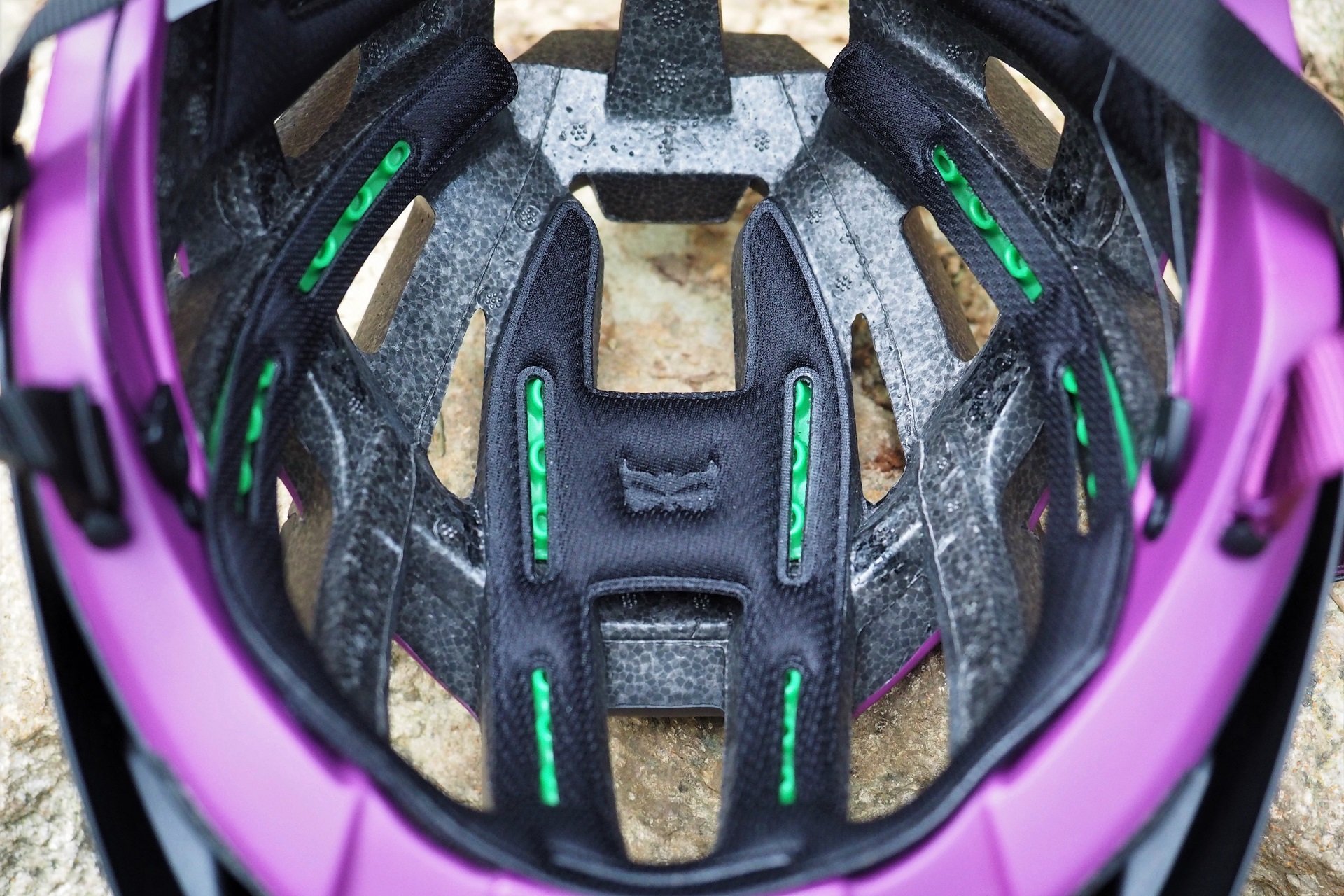
The Low-Density-Layer in Kali's top-end helmets is their solution to rotational forces.
One potential concern about the MIPS slip-plane system is that thin plastic shell inside the helmet could prevent the helmet foam from crushing. Brad is quick to point out that this could easily be taken into account as part of helmet design but I've tried on enough non-MIPS helmets and their, tighter fitting, MIPS-equipped twins to notice that most helmets with MIPS weren't redesigned for the integrated low-friction-layer insert.
Still, should I feel justified in spending a few extra bucks for a MIPS helmet over the non-MIPS equivalent? Absolutely, according to Brad.
"Cooler Helmets Mean Harder Foam"
I'm going to jump in front of Brad here and ask two questions:
- Have you seen a helmet that appeared undamaged after a crash that resulted in a concussion?
- Have you noticed a helmet promotion that seemed to present style as the most critical element ?
Let's discuss.
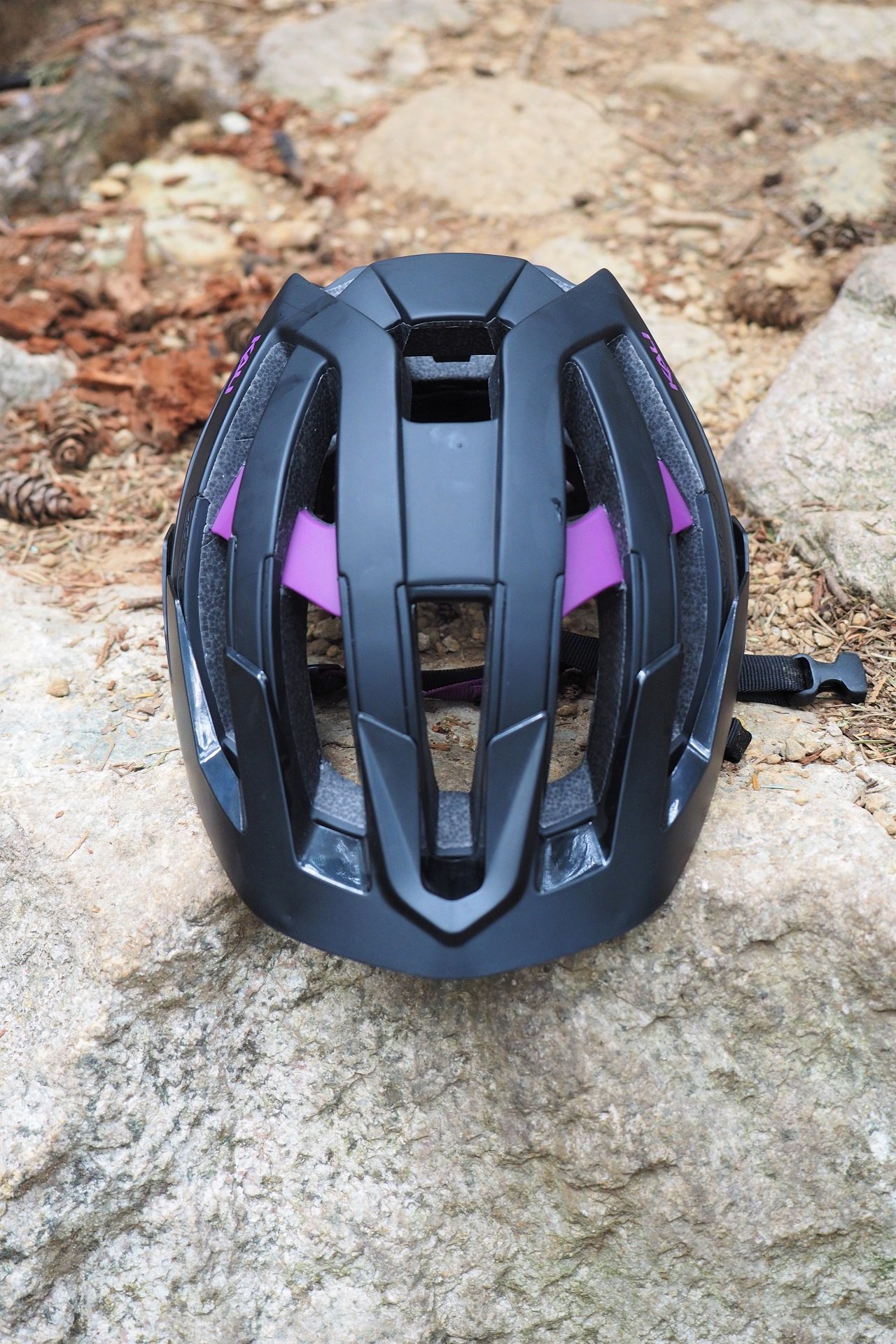
The Interceptor combines low weight, great venting, a low-density-layer, and multi-density foam for 180 USD.
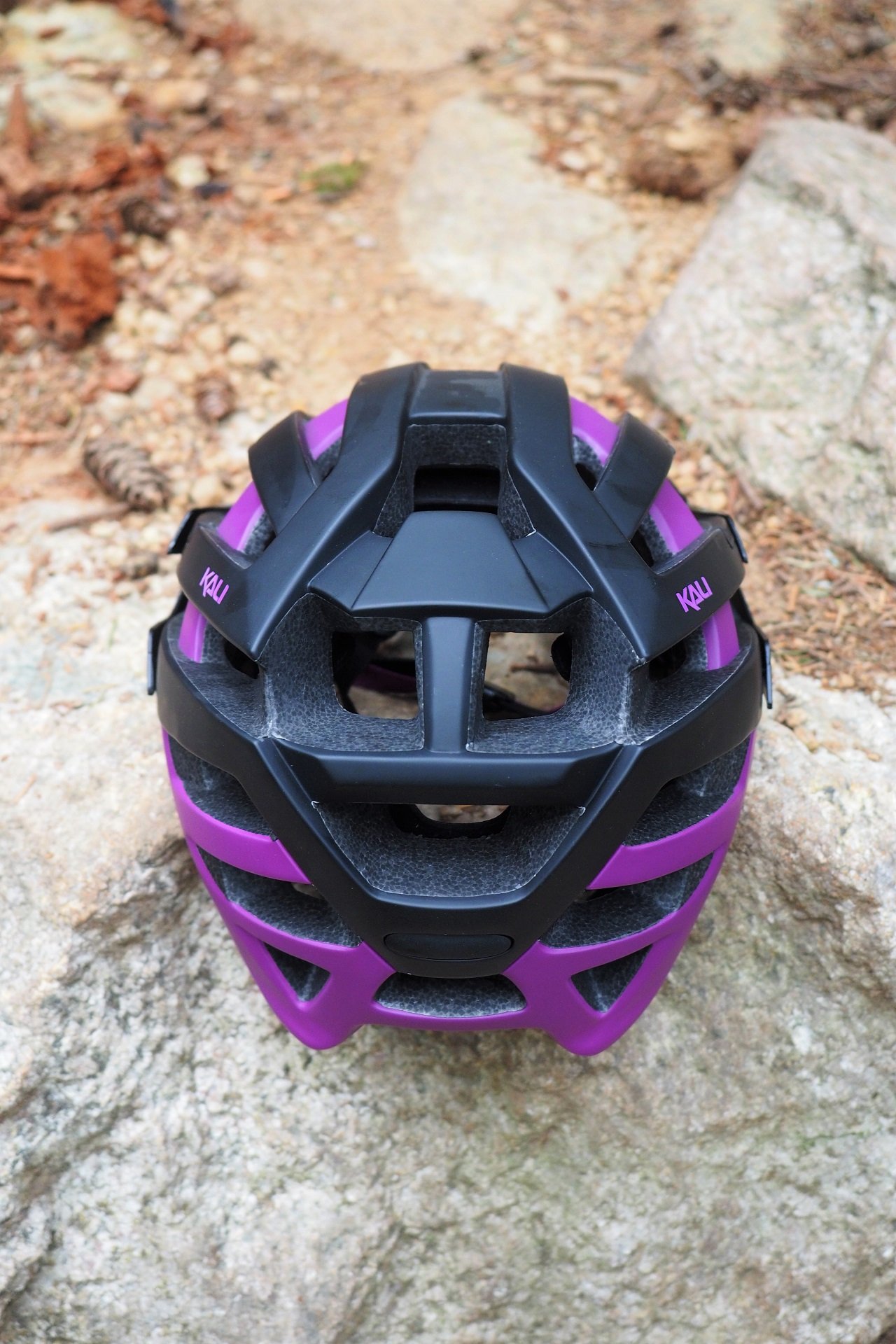
The challenge in designing "cool" helmets with low-density foam is it doesn't handle sheer loads like harder foam.
No matter the application, every rider wants a cooler lid. I'm of course talking about maximum passive and active venting and also looking wicked in my colour-matched kit and fanny pack. In order for that sweet ultra-high-end road lid to be more air than shell while passing government standard, harder foam must be used. The same is true for the crazy shapes on some of the best looking DH and Enduro lids. Without naming companies, in Brad's experience, if a helmet doesn't pass those tests it's entirely possible to "just firm up the foam" until it does. To the layman the tests these helmets are passing are the only comparative safety metric that we have.
"Safety Is Not An Upgrade"
And just like that, I'm back to a product triangle; cheap, vented, safe, pick two. The closer a helmet looks to the bucket you see kids (hopefully) wearing at the local skate park, the easier it is to cheaply incorporate low-density foam. For example, Kali's Viva bucket is 50 USD and their only bicycle helmet that incorporates the same multi-density triangular shaped EPS foam as their 450 USD Shiva DOT moto lid. Just looking at a picture of the Viva has my eyes burning from a waterfall of sweat.
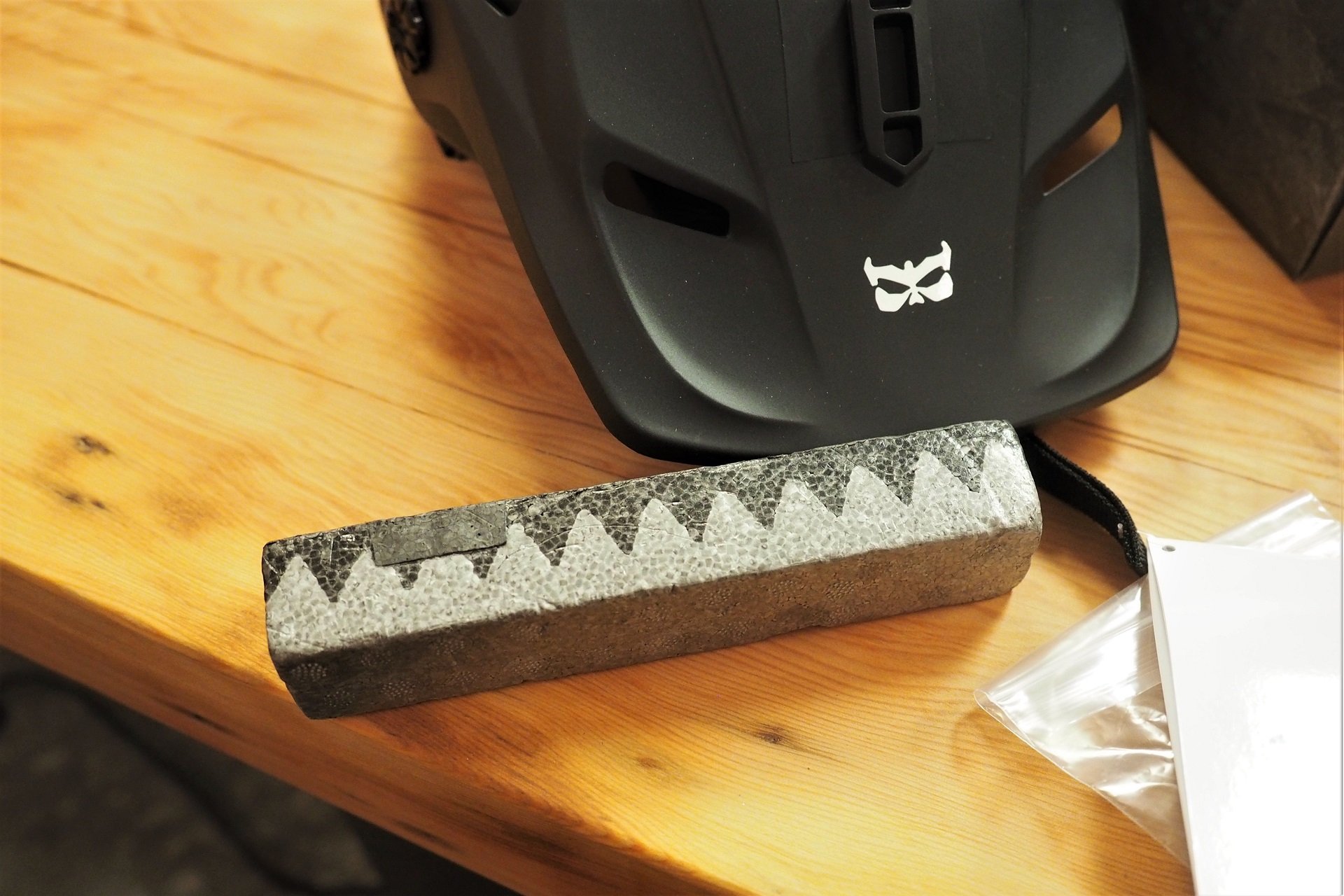
Am I willing to trade comparatively less venting for comparatively softer foam at a given price point? Tough question.
One of Kali's best selling helmets is their 100 USD Maya. At this price the lack of venting compared to some competing 'Enduro' helmets is obvious. I recognize I'm towards the sweatier end of the spectrum but I'm thinking this is a half-shell that would be getting strapped to my pack anytime I was in for a long, hot fire road climb.
Brad shrugs. In his worldview, I'm still buying helmets the old way. Essentially, I'm looking to invest in lighter weight and maximum venting rather than buying the safest helmet within my price range. His goal is to use the softest foam possible and his stretch dream is to put a low-density-layer in every helmet Kali sells.
I'm knocking on a maple table as I say this but I've only rung my bell hard a few times in years of riding and, with the one exception of trail riding in a super-light road lid, I've felt my helmets did their job. I sweat a lot and once summer hits I'm taking off the most vented lid every time I stop.
Softer foam or more venting? For me it's a tough question.







Comments
[user profile deleted]
5 years, 10 months ago
This comment has been removed.
Andrew Major
5 years, 10 months ago
My problem is two fold - one I’m sweaty as... so I always want a breezy road lid (wore them for years) when the suns out BUT, knock on wood, I’ve had my worst head-to-unmoveable-object crashes on trails where I wouldn’t normally wear a more aggressive lid if I was to divvy up my riding.
Actually the worst close call (almost out my head into a cut off stump) I’ve had this year was wearing a Leatt DBX 3 with the chinbar strapped to my pack :-(.
Reply
Kenny
5 years, 10 months ago
I had a crash this year with my DBX chinbar strapped to my pack. Broke the suspension of the helmet (the attachment points on the side are very, very thin plastic). Was not a hard hit but it was a head hit nonetheless.
I was disappointed that the suspension broke, again it was not a very hard hit. But deifnitely sketched me out that I was not wearing the chinbar and had a pretty good crash, it could have been much worse.
I bought a proframe.
Then I had second thoughts about not having a convertible and also bought a Super DH (suspension attachment looks better than the Leatt, BTW). Hahaha
I broke my collarbone in that crash so I haven't tried either of them. That's what you get when you're injured. Sit around on the couch buying helmets all day.
I also emailed Leatt to let them know I'd crashed and the helmet had broken at that point, not at all in a bitchy way, I thought they might be interested in more details. I was totally willing to but another one. They never emailed me back. Pretty wierd.
Anyways I will be riding again as of this weekend so I will soon have first hand impressions with both the Leatt, Super DH, and Proframe.
I do like Kali's approach to safety. If they make a convertible lid. I suspect it will be a banger (hopefully not literally).
Reply
Andrew Major
5 years, 10 months ago
Re. E-Mail:
I've worked in customer-facing roles in the bike industry for a decent number of years. It never ceases to amaze me how many people e-mail me back after getting an e-mail response just to say something along the lines of "Wow, thank you for promptly responding to my e-mail". I mean, are expectations that low?
I can't comment on Leatt as I've never dealt directly with the brand. All my personal dealings with them have been through their Canadian distributor NRG. In all my experiences over a number of years the customer service I've received from NRG has been prompt and excellent.
.
In writing for NSMB I have a different (much lower) expectation since I'm not a customer who has shelled out money for a product and needs support from the brand I've supported. It still never ceases to amaze me, however, how frequently people and companies do not deliver on their commitments.
Reply
Kenny
5 years, 10 months ago
Yeah it's wierd, to be fair my buddy managed to damage the trim on the bottom of his chin bar and Leatt were super helpful to him. So maybe a fluke,
Anyways I learned my lesson on that one, having bought the Leatt online. I bought the proframe and super DH locally. :)
Reply
Bogey
5 years, 10 months ago
Andrew, unfortunately this same lack of response is the norm many industries.
I manage a large test laboratory and my standard is to respond to a client within 24 hours. All that is required is an email or phone call stating that we’ve received your inquiry and will be in contact soon to get further details and provide a quote.
We keep data on our response time and can relate it to projects won or lost. It is amazing how many clients tell us that our competitors haven’t gotten back to them at all!
Reply
Andrew Major
5 years, 10 months ago
I'm actually shocked how many people have related similar accounts to me. I've always assumed that prompt communication is a pillar of running a successful business.
Insane.
Andrew Major
5 years, 10 months ago
Re. Helmets
Looking at the DBX 3 I have here I'm not surprised the catch broke from a direct hit. I absolutely trust this helmet to do its job (and I love how it fits both with and without the chin-bar) but without the chin-bar sandwiched between either side of the catch, there's really nothing to support it.
I'd love to hear about your Proframe experience. I really like the idea of it especially after talking to Brad@Kali - who is not a fan of latch systems but does get asked about more trail-friendly full face helmets regularly. Unfortunately, the Proframe didn't have a fit or level of adjustment that works for my head.
Welcome back to the trails!
Reply
Kenny
5 years, 10 months ago
Haha Thanks! It actually wasn't the catch that broke, it was where the suspension attaches to the helmet inside, like where the end of the ratchet adjustable headband attaches.
Yeah my hope with the proframe is that on rides like short seymour laps it breathes well enough I can just put it on and leave it on. I agree it seems Fox should offer a broader range of pads, it seems your issue is pretty common. I have a large with the thickest pads in it (my DBX 3.0 was a large) and it's ok but it could be tighter. A medium with the thinnest pads wanted to eject itself off of my head though. We'll see how it goes.
I got the super DH because I am thinking that for bigger rides, like say Lord of the Squirrels, the convertible is still going to be the ticket. Overall impression is it's definitely beefier than the DBX 3.0, but I can feel the weight difference when standing around, will see how it is on the trails. It's about 100g heavier than both the DBX 3,0 and the proframe.
Reply
slyfink
5 years, 10 months ago
I have one of those Interceptors. I quite like it. It's quite breezy. My main complaint is that those green dimples start digging into my head after about an hour. After 2 hours, I feel like I have a vise clamping down in two very precise spots on my head. It's beyond uncomfortable, and pushes into painful territory. When fall riding with a lamp on top, it's excruciating until I start riding with a tuque. Maybe this is a design element to look into? The Leatt version (blue dough) looks like it wouldn't do that... Something to think about?
One question for you : if the Kali uses softer foam, does that mean the "knock" that renders it useless would have less force? I.e. We're told that a helmet is a single-use piece of equipment. One blow to the head, and it should be replaced. The question always is, how big of a blow does it have to be to count? So my question is: if Kali uses softer foams, will the blow that tells me I should send it to the trash be softer? (e.g. I glanced my helmet off the tree trunk I was passing under because I misjudged how low it was vs. I high-sided and whiplashed my head onto concrete with great force)
Also, does that soft foam make it more or less susceptible to those small dings and dents from putting your helmet in your gear bag, or hanging in from the bars while pushing up the hill, or having it roll around the trunk when driving to and from the trail?
Reply
Andrew Major
5 years, 10 months ago
Lots of great questions - thank you!
So first, yes the helmet is less likely to survive a crash. And apparently that’s not the universal selling feature I would think it to be. I’ll be talking a bit about Kali’s crash replace policy when I review the Interceptor but here’s the info : https://kaliprotectives.com/register
Regarding the hotspot you’re feeling ((Insert some kind of Disclaimer with legal mumbo jumbo and some common sense statements and some talking to you like you’re an idiot and also five)) I have a funny shaped crown and have had to do VERY TINY modifications to many helmets over the years to avoid that water torture sensation. I’ll get an official word but personally I would think nothing of trimming the ArmorGel formations at the pressure points you’re feeling. ((Insert some Disclaimer about consulting a helmet modification professional and not trying this at home and etc))
In the case of the Interceptor the softer foam is sandwiched between harder foam to handle sheer loads of the venting/inmoulding so it should be no more susceptible to the little incidents you’re referencing.
Hope that’s helpful!
Reply
Andrew Major
5 years, 10 months ago
Here’s the official word from Kali on modifying the ArmorGel inserts:
“Yes sometimes you may need to trim a LDL insert or remove it altogether.
Removing one or two inserts will have no ill affect on LDL performance.”
Reply
slyfink
5 years, 10 months ago
wow! I was not expecting that answer. Sweet as! I'll have a look tonight.
re the other point about softer helmets not being a selling point: I guess I'm of two minds this. Yeah, it sucks to replace your helmet, those things are ridiculously expensive (MEC sells the Interceptor for $250!). But I've always replaced my helmet after a good ding, and never use them for more than two seasons anyways.
On the other hand, I've always thought that piss-pot helmets for the skate park and such were more than single use. I thought that outer shell protected the foam in the helmet making it last longer... Is this misguided?
Reply
Speedster
5 years, 10 months ago
My gauge on helmet replacement is - if I’ve hit hard enough to “feel it” on my head, and know that I hit significantly, I’ll replace it. I don’t crash very often, and I usually get as high end of a helmet as I can afford, so it isn’t an insignificant amount of money.
I figure that if I spend thousands on my bikes, why would I not spend a few hundred bucks on proper helmets? Insert your own vice that you spend a lot of money on (bikes, beer, weed, food, coffee, etc) and figure out if your head is worth getting the best that you can. I’ll cut out a few coffees or beers per month or week in order to get a good lid.
Reply
Andrew Major
5 years, 10 months ago
I've certainly tossed (after cutting out the straps) a couple of lids where I was sure the impact I took was significant enough that if they didn't fail they should have.
After talking to Brad, I will certainly look at helmet pricing differently going forwards. Looking back a lot of the really pricey lids I've owned had - and advertised - internal skeletons to reinforce their structure so they could have cool shapes and massive venting.
Reply
mike
5 years, 10 months ago
Fullface rider myself , currently using the latest Urge Archi-Enduro helmet . After looking at the Kali , it has similar features , one being Non Mips which is exactly what I want . My buddy ride one of the newer Kali's and has used their FF helmets for years. He carries it on his back for the climbs , me I put it on and only remove to eat or for extended breaks .
Reply
Please log in to leave a comment.